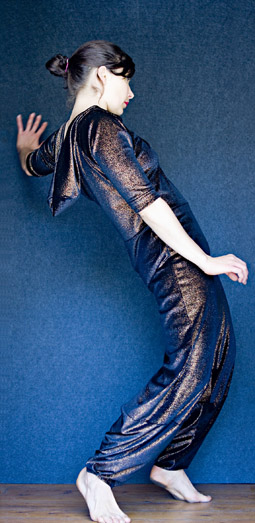 |
Deanne Butterworth, Vianne photo Rohan Young |
This figureless flux, looking incidental but clearly structured to a T, reveals an interest in chaos quaintly parallel with the 1950s discovery of quantum physics. The need to test the depth of macro order in apparent micro-level chaos resulted in chance choreographies by Merce Cunningham and Judson Church, with their shuffling and remixing, confusing the mind trying to make meaning. Vianne produces similar frustration with its density of signs and paucity of explanation.
Phillipa Rothfield observes the necessity to introduce frames, spatial or temporal, integral or external to the piece, in order to make sense of Vianne [RealTime 89]. With the elements recombining at a frequency that does not allow us to take in the whole stage action, focus must narrow, and two people making sense out of this knot of emotion and indifference, symmetry and disorder, will make very different overall conclusions.
Five excellent dancers (Deanne Butterworth, Bonnie Paskas, a slightly pregnant Jo Lloyd, Timothy Harvey, and Lee Serle fresh from Chunky Move's Mortal Engine) group and regroup against the sound of crowd buzzing through resounding, transitional space (the sound of an airport) turning into flat, synthetic beats. The interaction between the dancers unfolds and contracts: Butterworth, a peachy stand-out among the black costumes, engages in an intimate duet, albeit tinted with hostility, with Paskas, who will then fluidly cut herself out and into a duet with Harvey. The movement ranges from physically broad (often vaguely aggressive or loving, but never even remotely figurative) to filigree. The closest Vianne gets to figuration is in choreographic moments that strongly mimic quotidian, mundane movement: stretching, walking, idleness, attentive observation. Lloyd and Paskas seem to engage in a tactile routine of mutual encouragement (head gripped, fists clenched, eye contact sustained); the same sequence has, by the end, migrated onto a different couple, this time Lloyd and Serle.
Choreographic loops are closely reiterated, abandoned and returned to: Lloyd will approach Serle in an invitation to physical combat over and over again, each time ending up prostrate on the floor, his foot slowly migrating up her thigh in a cryptic moment of aggression and seduction. She will then try to teach him a formal salute (he learns to her satisfaction, each reiteration shorter and more fluid). Some trios look like an illustration of family dynamics: broody Harvey, suspicious Paskas, overzealous, jogging soccer-mum Butterworth.
The breadth and density of the choreography is astonishing: audience members must choose their focus, as different duets and solos unfold in the same space. Movement will often stretch and jump, dancers tearing off groups to join into another, sequences mirrored across what sometimes looks like dancefloor chaos. The build-up of speed and hostility slowly dissolve in the last third, the airport noise returns, the conflicted duets turn inside out into repeats of the early signs of affection: hugging, encouragement.
Without interpretive coordinates, everything is potentially significant: the soundtrack, veering from electronic white noise to electric organ harmonics; the red-lit back wall; the silicon cube Serle and Harvey rig up in the centre of the stage and which the dancers dance through, then women dismantle with focus but utter inscrutability.
Both in its first run, and now at the Dancehouse, Vianne happens (for 'happens' is the right word) in a room bathed in natural light; and both times it is scheduled during crepuscule, when the crisp post-sunset light fades into night. A spotlight affixed to the external wall at Fortyfivedownstairs, mimicking streetlights, has been replaced with one in the corner of the Dancehouse studio, suddenly illuminating the darkening room with a loud flick of the switch.
There is a lot of watching in Vianne, a lot of eye contact. No intimate moment from one dancer is ever disconnected from the others, not even when they are still: a duet between Paskas and Harvey at the back of the stage is observed carefully both by us and an entire row of dancers, covering our view. The observer's eye touches the observed and intrudes, changes the image. Like bored airport-dwellers, each dancer takes their turn to sit or stand by the wall, silently observing others dance. Sometimes they breathe heavily, exhausted. Sometimes they merely look, with the vaguest spark of personal interest.
The overall effect is uncannily like observing the street, a train station or an airport, possibly in a foreign country. After a while, one starts noticing rhythms and patterns in the large, uncoordinated mass of movement. The decipherable figure moves in and out of the interpretive grid. One makes up relationships, coordinates love and hate, invents purpose and assigns labels. When at a loss to explain the behaviour of these 'foreigners', one interprets with what one has: the street light, the train schedule, the music on the radio.
Of all the performance Australia has seen lately, it is paradoxically Nature Theater of Oklahoma's No Dice (seen at this year's Sydney Festival) that comes closest to Vianne. No Dice maniacally accumulates the minutiae of everyday conversation, driven by the same need to recreate the vast rhythms of cosmic murmur in the black box; but NTO's project was leavened by a pop sensibility, and expansive humour. Without a semantic aim, the main goal of Vianne's stern choreography remains to inscribe open movement in theatrical space, to extend the stage beneath the dancing feet to the uninterpretable chaos of the city.
Vianne, choreography Shelley Lasica, performers: Deanne Butterworth, Jo Lloyd, Timothy Harvey, Lee Serle, Bonnie Paskas, music: PEACE OUT! (Milo Kossowski, Morgan McWaters, from Melbourne band The Emergency), set Anne-Marie May, costumes Shelley Lasica, Kara Baker for Project, lighting Ben Cobham; Dancehouse, March 10–11; Dance Massive, March 3–15
© Jana Perkovic; for permission to reproduce apply to [email protected]








 back
back